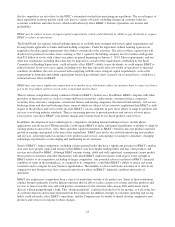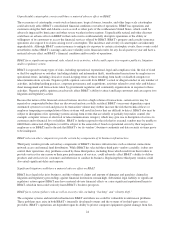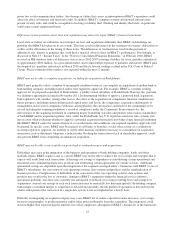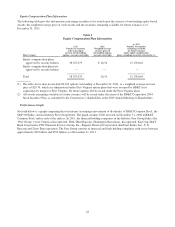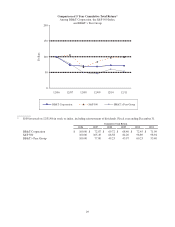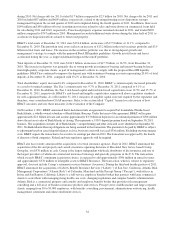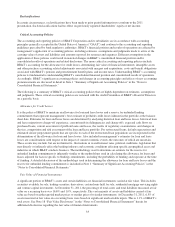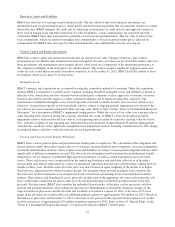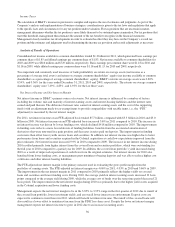BB&T 2011 Annual Report Download - page 33
Download and view the complete annual report
Please find page 33 of the 2011 BB&T annual report below. You can navigate through the pages in the report by either clicking on the pages listed below, or by using the keyword search tool below to find specific information within the annual report.Reclassifications
In certain circumstances, reclassifications have been made to prior period information to conform to the 2011
presentation. Such reclassifications had no effect on previously reported shareholders’ equity or net income.
Critical Accounting Policies
The accounting and reporting policies of BB&T Corporation and its subsidiaries are in accordance with accounting
principles generally accepted in the United States of America (“GAAP”) and conform to the accounting and reporting
guidelines prescribed by bank regulatory authorities. BB&T’s financial position and results of operations are affected by
management’s application of accounting policies, including estimates, assumptions and judgments made to arrive at the
carrying value of assets and liabilities and amounts reported for revenues and expenses. Different assumptions in the
application of these policies could result in material changes in BB&T’s consolidated financial position and/or
consolidated results of operations and related disclosures. The more critical accounting and reporting policies include
BB&T’s accounting for the allowance for credit losses, determining fair value of financial instruments, intangible assets
and other purchase accounting related adjustments associated with mergers and acquisitions, costs and benefit obligations
associated with BB&T’s pension and postretirement benefit plans, and income taxes. Understanding BB&T’s accounting
policies is fundamental to understanding BB&T’s consolidated financial position and consolidated results of operations.
Accordingly, BB&T’s significant accounting policies and changes in accounting principles and effects of new accounting
pronouncements are discussed in detail in Note 1 “Summary of Significant Accounting Policies” in the “Notes to
Consolidated Financial Statements.”
The following is a summary of BB&T’s critical accounting policies that are highly dependent on estimates, assumptions
and judgments. These critical accounting policies are reviewed with the Audit Committee of BB&T’s Board of Directors
on a periodic basis.
Allowance for Credit Losses
It is the policy of BB&T to maintain an allowance for loan and lease losses and a reserve for unfunded lending
commitments that represent management’s best estimate of probable credit losses inherent in the portfolio at the balance
sheet date. Estimates for loan and lease losses are determined by analyzing historical loan and lease losses, historical loan
and lease migration to charge-off experience, current trends in delinquencies and charge-offs, expected cash flows on
purchased loans, current assessment of problem loans and leases, the results of regulatory examinations, and changes in
the size, composition and risk assessment of the loan and lease portfolio. For restructured loans, default expectations and
estimated slower prepayment speeds that are specific to each of the restructured loan populations are incorporated in the
determination of the allowance for loan and lease losses. Also included in management’s estimates for loan and lease
losses are considerations with respect to the impact of current economic events, the outcomes of which are uncertain.
These events may include, but are not limited to, fluctuations in overall interest rates, political conditions, legislation that
may directly or indirectly affect the banking industry and economic conditions affecting specific geographical areas and
industries in which BB&T conducts business. The methodology used to determine an estimate for the reserve for
unfunded lending commitments is inherently similar to the methodology used in calculating the allowance for loans and
leases adjusted for factors specific to binding commitments, including the probability of funding and exposure at the time
of funding. A detailed discussion of the methodology used in determining the allowance for loan and lease losses and the
reserve for unfunded lending commitments is included in Note 1 “Summary of Significant Accounting Policies” in the
“Notes to Consolidated Financial Statements.”
Fair Value of Financial Instruments
A significant portion of BB&T’s assets and certain liabilities are financial instruments carried at fair value. This includes
securities available for sale, trading securities, derivatives, certain loans held for sale, residential mortgage servicing rights
and venture capital investments. At December 31, 2011, the percentage of total assets and total liabilities measured at fair
value on a recurring basis was 16.6% and 1.0%, respectively. The vast majority of assets and liabilities carried at fair
value are based on either quoted market prices or market prices for similar instruments. At December 31, 2011, 6.5% of
assets measured at fair value on a recurring basis were based on significant unobservable inputs. This is 1.1% of BB&T’s
total assets. See Note 18 “Fair Value Disclosures” in the “Notes to Consolidated Financial Statements” herein for
additional disclosures regarding the fair value of financial instruments.
33


